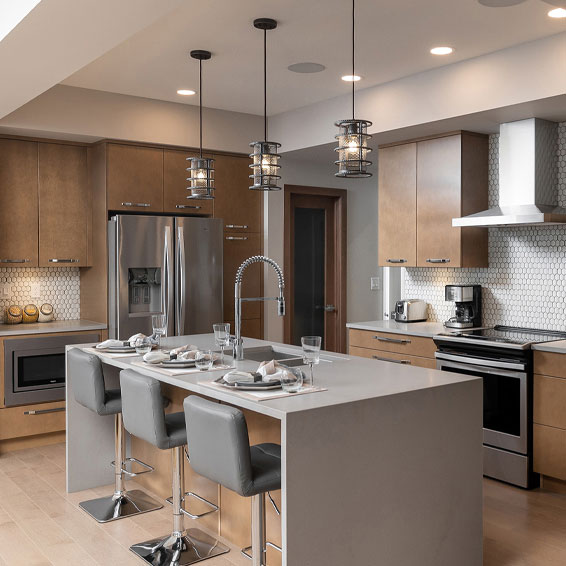 Planning which colours to apply to your home’s interior is certainly a creative adventure, but there are variables to consider if you want to achieve a sense of balance and comfort. A good starting point for your painting journey is to look at the function, size, and dimensions of each room.
Planning which colours to apply to your home’s interior is certainly a creative adventure, but there are variables to consider if you want to achieve a sense of balance and comfort. A good starting point for your painting journey is to look at the function, size, and dimensions of each room.
Function
Colours in public rooms like dining rooms and living rooms should create a sense of comfort and relaxation for both your family and visitors, while imparting an understated bit of sophistication. Pale greens, muted blues, and light browns or beiges are good choices for these areas because they’re comforting, tend to stay in style, and complement most kinds of furniture.
In contrast, the kitchen is a more active, stimulating, and bustling room where subdued shades may feel too lethargic or unlively. Suitable kitchen colours like red-orange, light blue, and lime green – along with balancing shades of white – can lend a clean, energetic atmosphere that uplifts the spirit and keeps you motivated.
In the more private bedroom, creative expression through colours that reflect your own personality is desirable, but they should also create a sense of rest and relaxation. Cool, muted colours are usually preferable here, as warm and bright vivid colours are more stimulating and less conducive to winding down.
Guest rooms should generally also have cool and soft colours to encourage comfort and relaxation for overnight visitors, whereas kids’ bedrooms are often decorated with brighter shades to energize their young bodies and minds.
 Size
Size
A room’s size and dimensions are also key players in the colour-choosing process. In most cases, light paint colours visually expand a room’s size, whereas dark shades create a feeling of intimacy and contraction. Dark colours fare well in big rooms with high ceilings and plenty of natural sunlight, while light colours are better in small rooms with little incoming daylight.
Accent walls that contrast in colour with the others can also blur a room’s size and dimensions. As they may create a sense of clutter or chaos in a small room, accent walls are usually avoided or painted in neutral colours that don’t stand apart as much from the other walls.
Large rooms tend to be more suitable for accent walls or graphic borders. If you do opt for a multi-colour scheme in a particular room, pick out colours that are naturalistic or that harmonize/complement each other on a standard colour wheel.
Now that you have an idea of which paint colours are most effective in a room based on its square footage and function, you can start making definitive choices on colours for specific elements in your home:
Step 1: Pick Your Base White.
Your base white should be your primary tone for doors, trims, closets, and cabinet interiors. Ideally, you want this shade of white to reflect the undertones of your cabinet doors, floors, and furniture.
For instance, off-white or white with a hint of yellow harmonizes well with natural wood style cabinets, while cool whites with blue or grey undertones complement painted cabinets well.
Step 2: Pick Your Neutral.
Use this as your primary tone for your foyer, hallways, and other interlinking spaces. Neutrals are simply very subdued shades of any colour in the spectrum, but beiges and greys are the tones most commonly associated with the term.
Step 3: Pick One Bold Colour.
The shade of this paint will serve as the launch pad for your other colours, so it should be your favourite, or one of the top contenders. This bold or “saturated” shade doesn’t necessarily have to be dark or super vivid, but it’s the colour that will be most prominently displayed throughout your whole home, especially on your walls, furniture, and possibly flooring in certain areas.
 Step 4: Pick a Partner For Your Bold Colour.
Step 4: Pick a Partner For Your Bold Colour.
If your home’s colour palette is essentially monochromatic, this shade should be a lighter version of your bold colour. If you want a harmonious colour palette, pick out a tone that borders your bold colour on a standard colour wheel. If you’re going for a complementary colour scheme, find a colour you like then move directly across the wheel and choose that colour or one on either side of it.
Step 5: Pick a Colour For Accenting.
If you do plan on having accent walls, you’ll probably want to stick to one shade throughout the house to create a sense of unity. But feel free to mix up its application a bit for variety, using it not just as a single wall colour, but also as the primary colour in specific spots like nooks, enclosures, etc.
After you’ve chosen a few colours for each step, test them out by applying a small patch of each of them to your walls. Allow the paint to dry completely, then make your final decision.
If you feel overwhelmed at first, remember that choosing your home’s colour scheme is more of an art than an exact science. There is no single perfectly coordinated scheme that must be strictly adhered to. By following the simple steps above with an open mind and planning with care, you will avoid the expensive mistake of painting walls and surfaces random colours, only to end up with a disharmonious scheme that is hard on the eyes and has to be redone.
When you choose to work with Sterling Homes, your own personal design consultant at our designQ can help you! And be sure to check out up-and-coming paint palettes for 2018 for more inspiration.




